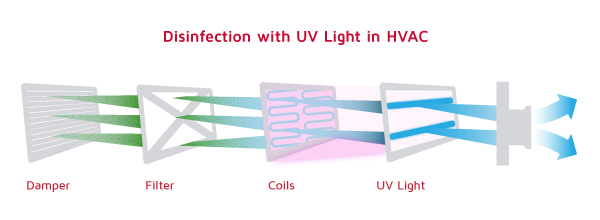Whether you’re looking to upgrade your HVAC system or needing help with eliminating mold, mildew or bacteria, ultraviolet or germicidal lights may be what you need. But how do they work?
Types of UV Light
Ultraviolet (UV) light is designed to produce UV radiation (a form of electromagnetic radiation) that comes from different places, the primary source being from the sun. They are measured in nanometers (nm) and are divided into three categories:
UVA—315-400 nm, long wave, not absorbed by the ozone layer (commonly called black light)
UVB—280-315 nm, medium wave, 95% are absorbed by the ozone layer
UVC—100-280 nm, short wave, all absorbed by the ozone layer (referred to as germicidal)
UVB light is the main cause of sunburns and skin cancer. However, it is also the main source of vitamin D, which helps with bone development and helps the body absorb calcium. UVB and UVA lamps can be helpful in treating skin conditions, mood disorders and other health conditions.
UVC lights, due to short wavelength frequencies, are germicidal, which means they can help eliminate germs and bacteria in the air, in water and on surfaces. They are used in UV air purification systems and can be used in HVAC systems to prevent mold buildup.
Using UV Light to Kill Mold
Mold is part of our natural environment; it is a fungus that is made up of small organisms that can be found everywhere, indoors and outdoors. Mold becomes a problem indoors when mold spores touch wet surfaces and grow as it can have a big impact on air quality in your home. Spores will enter the air and can be inhaled by anyone. The best way to control mold growth is to control moisture.
Because UV light has a higher frequency than regular light, it can be very effective at killing mold spores as well as disinfecting bacteria and viruses without needing to use any harsh chemicals. If you install a UV lamp, it may help block some molds from growing on the moist surfaces, such as cooling coils, drain pans and ductwork.
UV light sends out short wavelengths of energy that penetrate mold. This disrupts the chemical bonds within the mold cell, impacting its genetic material and inhibiting its ability to replicate. The effectiveness of the UV light depends on the length of time the mold is exposed to the light as well as the intensity you’re using; the higher the intensity, the more effective it will be at damaging the organism, preventing it from reproducing.

Can UV Light Eliminate Harmful Bacteria?
UV light is highly effective at eliminating many types of bacteria including drug-resistant bacteria called superbugs, viruses (including many types of flu strains), beta coronaviruses (including MERS, SARS) and the SARS-CoV-2 virus that causes COVID-19. However, the effectiveness of UV lamps in killing the SARS-CoV-2 virus is unknown because there is limited published data about the wavelength, dose and duration of UV radiation required to stop the virus.
Not all UV lamps are the same. Lamps may emit very specific UV wavelengths (like 254 nm or 222 nm), or they may emit a broad range of UV wavelengths. Some lamps also emit visible and infrared radiation. The wavelengths emitted by the lamp may affect the lamp’s effectiveness at killing a virus and may impact the health and safety risks associated with the lamp. Some lamps emit multiple types of wavelengths. Testing of the lamp can determine whether, and how much, other wavelengths the lamp puts out.
Generally, UV cannot kill a virus or bacterium if it is not directly exposed to UV, meaning the virus or bacterium will not be killed if it is covered by dust or soil, embedded in porous surface or on the underside of a surface.
Benefits of UV Lights in Your HVAC System
• Improves efficiency and airflow by cleaning the coils and the air that passes through your unit.
• Reduces energy costs: A cleaner unit means lower energy bills.
• Eliminates mold/mildew and kills bacteria by disinfecting moist edges and grooves with no toxic chemicals.
• Reduces odors, allergies, asthma and respiratory symptoms by providing an extra layer of protection.
• Improves indoor air quality by sanitizing the air before it’s circulated throughout your home.
Disadvantages of UV Lights
• They can be expensive to install (between $1,000-$2,000).
• They need regular maintenance (should be replaced every one to five years depending on the light).
• If installed improperly, they can damage your system.
• Potential safety hazards when exposed to the UV rays directly or indirectly.
• Effectiveness is limited because they can only kill germs that pass through its rays.
Can You Install a UV Light Yourself?
UV lights are safe and effective but are not considered a DIY job. They have to be installed properly into your HVAC system and can be damaging to your eyes or skin if exposed to their rays.
Lennox’ Healthy Climate® Induct Air Purifier remove contaminants like mold, mildew and bacteria by using maximum-intensity ultraviolet light, which improves the health of your equipment and protects your family members with allergies, asthma and other health-related conditions.
Consulting with a professional can help you make an informed decision about integrating UV technology into your HVAC system, ensuring a healthier living environment for you and your family. Book an appointment with your local Lennox Dealer to find the best indoor air quality solutions using UV lights.

